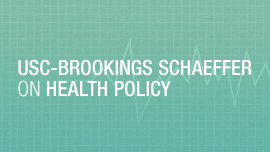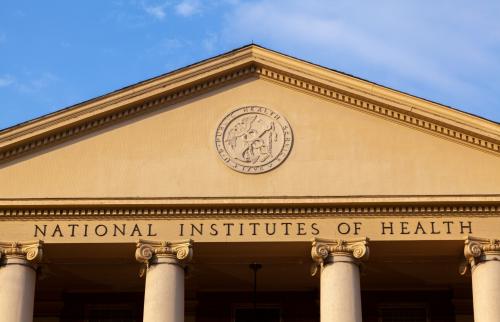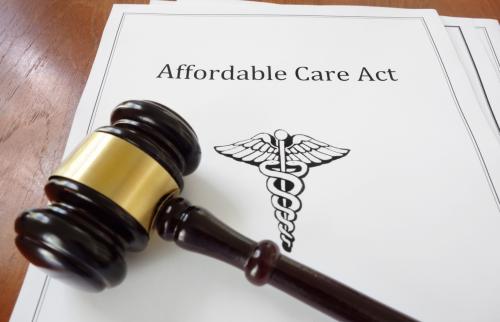This analysis is part of the USC-Brookings Schaeffer Initiative for Health Policy, which is a partnership between Economic Studies at Brookings and the University of Southern California Schaeffer Center for Health Policy & Economics. The Initiative aims to inform the national health care debate with rigorous, evidence-based analysis leading to practical recommendations using the collaborative strengths of USC and Brookings.
As negotiations over reconciliation legislation continue, the ERISA Industry Committee (ERIC) and the Purchaser Business Group on Health (PBGH) – two trade groups representing employers – are suggesting that their support of the bill’s drug pricing provisions is contingent on employers getting to benefit from any regulatory drug price reductions, not just Medicare. While employers understandably want to pay lower drug prices in tandem with any Medicare regulation, which in turn would also translate to lower costs and/or higher wages for workers, these employer groups (and others) are also arguing that drug manufacturers would recoup revenues lost from Medicare patients by extracting higher prices from employers and other private market purchasers. Specifically, they write:
These plan sponsors and our plan participants financially support the overall U.S. health care system (including the prescription drug market) as critical payers, subsidizing public programs by offsetting costs that government programs, such as Medicare and Medicaid, do not fully cover. Any prescription drug pricing reform which does not allow private payers to take advantage of the same cost containment mechanisms government programs enjoy will only serve to further drive up the prescription drug costs for millions of Americans in the form of additional cost-shifting.
However, I argue in this piece that there is little reason to expect such effects in the near-term, and any longer-run indirect effects on drug prices in the commercial market are likely to be small. Further, for a subset of drugs, there are reasons to believe that the opposite is likely to be true – that reducing Medicare prices should also reduce the net prices paid by employers. There are many parallels to hospital pricing, where empirical analyses consistently find no evidence for this sort of “cost-shifting.”
In what follows, I first explain why the causal pathways commonly posited to give rise to cost-sharing are implausible, but raise one other plausible (albeit attenuated) pathway that could generate limited cross-market effects over the longer-run. Next, I distinguish the scenarios where cross-market price effects should be expected, specifically in cases where there exist explicit price linkages between markets such as the Medicaid best price rule. Lastly, while unfortunately there does not appear to be any research to date testing for the presence of cost-shifting by drug companies empirically, I discuss the richer literature on hospital cost-shifting and how researchers can empirically test for cost-shifting in the drug pricing context.
Potential Pathways for Cost-Shifting
The cost-shifting hypothesis, in this context, posits that reducing the prices paid for drugs in Medicare will increase the prices that drug companies extract from payers in the commercial market. The hard question to answer is why lower prices in one market should lead to higher prices in another.
One common line of argument is that drug manufacturers target a certain level of earnings, so lower prices in Medicare would lead them to seek higher prices in the commercial market in order to keep total profits unchanged. However, this is only possible if drug companies are currently choosing not to maximize commercial market profits. Thus, to sustain the earnings targeting theory, proponents need to explain why drug companies—which are almost exclusively large for-profit companies—are leaving money on the table and thereby harming their investors under the status quo.
Another set of arguments posits that a fear of bad public relations or regulation restrains drug manufacturers from pricing higher at present, and that therefore manufacturers maintain untapped pricing power in the commercial market. Given that list prices for drugs are already often set at jarring levels that prompt media attention and that net prices are typically hidden, however, it is unclear how much, if any, restraint these fears actually generate. Moreover, to the extent they are restraining drug prices currently, it is unclear why these factors would diminish as constraints if Medicare started setting prices for certain drugs or implementing inflation rebate penalties, which would be necessary to explain why a reduction to prices in Medicare would increase prices in the commercial market. Indeed, one might expect the fear of price regulation in the commercial market to increase if Congress enacts such regulation in Medicare.
Lastly, a more plausible, albeit less direct, pathway to these types of cross-market effects is that Medicare price regulation could reduce the expected total market size for a drug class. This could, in turn, deter the marginal entrant, thereby reducing competition and increasing commercial prices for that drug class. Such effects may be attenuated, though, by the focus of recent Medicare drug price negotiation proposals on medicines without competition from therapeutic substitutes (in which case we would expect smaller reductions to the expected market size for multi-drug classes).
Potential for Cross-Market Effects When Explicitly Linked
Importantly, while the direct drug company cost-shifting stories appear unlikely, this does not mean that cross-market price effects cannot occur under certain conditions. Specifically, it is reasonable to expect cross-market effects when prices in each market are explicitly linked by policy.
For example, the Medicaid best price rule ties Medicaid drug prices to the lesser of a minimum statutory rebate amount off the average manufacturer price or the lowest price offered to a private payer (with some exceptions). This explicit linkage makes it more costly for a drug manufacturer to agree to lower prices with private payers because offering a sufficiently low price to a private payer would also lower the price the firm receives from Medicaid purchases. In turn, we should expect the existence of the Medicaid best price rule to somewhat increase prices paid by private payers, and indeed research from Mark Duggan and Fiona Scott Morton suggests that an earlier iteration of this policy increased private sector prices. Similarly, Medicare Part B rules that tie physician-administered drug reimbursement to a drug’s average sales price in the commercial market may have the effect of increasing commercial prices. And international reference pricing models, like those proposed by the Trump Administration or included in H.R. 3, may increase drug prices in the reference countries because agreeing to lower prices in the reference countries now automatically triggers lower prices in the U.S.
However, none of the proposals under consideration would newly link commercial market drug prices to those paid in Medicare. Indeed, many of these proposals would actually weaken the existing link between commercial prices and Medicare’s prices for physician-administered drugs by reducing the number of drugs subject to the average sales price payment methodology in Part B, thereby potentially reducing commercial prices. Some of these proposals could also reduce commercial prices by reducing the likelihood that commercial prices (rather than Medicare prices) are the binding “best price” used to determine the drug’s price in Medicaid.
Research Consistently Finds No Evidence of Cost-Shifting by Hospitals
Unfortunately, there does not appear to be any strong research to date empirically analyzing whether “cost-shifting” occurs in practice with pharmaceutical pricing. This is a testable hypothesis, however. For example, the cost-shifting theory suggests that a revenue reduction in another country or countries for a given drug – for reasons that would not be expected to simultaneously weaken the manufacturer’s negotiating leverage in the U.S. (e.g., not revenue reductions that stem from new evidence that a drug is less effective than previously thought) – would increase net prices of that drug in the U.S. Future research along these lines would be valuable.
While research on “cost-shifting” by drug companies is lacking, research in the context of hospital pricing consistently finds no evidence that price reductions in one market lead to higher prices in another. This evidence suggests that non-profit hospitals tend to respond to Medicare price reductions by commensurately reducing operating expenses and for-profit hospitals see a decrease in profits. Further, recent studies suggest that the opposite of cost-shifting occurs, that reductions to Medicare prices paid to hospitals have the spillover effect of reducing hospital prices negotiated in the commercial market. This spillover effect – theorized to occur either due to reductions undertaken to operating costs or an increased incentive to attract privately-insured patients in place of the publicly-insured – however, seems less likely in prescription drug markets because average production costs tend to be very low relative to prices and there are weaker supply constraints.
Notably, Chernew et al. (2021) do show that hospitals more reliant on Medicare revenue are more likely to close or be acquired, raising the possibility of what they term “consolidation-induced cost-shifting,” which is the parallel of the most plausible drug cost-shifting pathway described earlier. It is plausible, therefore, that a longer-term analysis of hospital cost-shifting might find some effects, although focusing on market level effects over a 15-year period, White (2013) still finds that reductions to Medicare prices lead to lower commercial market prices on average (the opposite of the cost-shifting hypothesis). Still, an even longer-run analysis could find different results, or it could be the case that the hypothesized spillover effects outweigh any consolidation-induced cost-shifting.
Additionally, the theoretical case for cost-shifting among hospitals seems stronger than among drug companies given that most hospitals in the U.S. are nominally non-profits. Many theorized, therefore, that hospitals might not set profit-maximizing prices in the commercial market, which combined with typically high levels of market power could plausibly create the conditions for cost-shifting to occur. On the other hand, pharmaceutical companies are almost entirely for-profit entities and most of the big manufacturers are publicly-traded, making the argument that these companies are not trying to maximize profits today less plausible.
While not identical, hospital markets are also subject to many of the same factors that observers use to argue for the presence of cost-shifting by drug companies. Both markets are characterized by high levels of market power, in many cases making a hospital or drug “must-have” for an insurer’s product offering. Both hospitals and drug manufacturers negotiate prices with insurers or other intermediate payers, with patients typically only paying a portion of the price. Both tend to set very high list prices, price discriminate across payers, and generally have secret net or negotiated prices. If the fear of bad public relations or price regulation is restraining drug prices, one would expect that similar fears would restrain hospital prices in the commercial market at present. And lower public payer prices could plausibly reduce the number of competitors in a market, in certain instances.
Yet, despite these similarities and the stronger theoretical case for the presence of cost-shifting from hospitals rather than drug companies, empirical analyses strongly suggest that no such cost-shifting exists or that, at most, there may be small consolidation-induced effects.
Conclusion
The cost-shifting hypothesis arises again and again, often from hospital or drug manufacturer executives themselves, but both economic theory and empirical evidence in the hospital setting suggest that it is unlikely to be significant in practice. The Congressional Budget Office appears to agree that cost-shifting will not occur, and indeed they suggest that implementing inflation rebates in Medicare will modestly reduce commercial net drug prices.
Notably in the case of hospital or drug manufacturer executives, it is in their company’s financial interest to perpetuate the idea of cost-shifting because they do not want cuts to revenue from treating Medicare patients. Judging by the fierce industry opposition to both hospital and drug price reductions, moreover, it seems clear that they understand that there is limited, if any, ability to cost-shift in practice.
Empirical research is needed to close the case, but there is little reason to expect Medicare price regulation to meaningfully increase prices in the commercial market. And for certain drugs, there is reason to suspect the opposite, that Medicare price reductions might even lower prices in the commercial market.
The Brookings Institution is financed through the support of a diverse array of foundations, corporations, governments, individuals, as well as an endowment. A list of donors can be found in our annual reports published online here. The findings, interpretations, and conclusions in this report are solely those of its author(s) and are not influenced by any donation.
-
Acknowledgements and disclosures
I thank Matthew Fiedler, Richard Frank, Rachel Sachs, and Benedic Ippolito for helpful discussions and comments, and Kathleen Hannick for excellent research assistance and web publishing.
The Brookings Institution is committed to quality, independence, and impact.
We are supported by a diverse array of funders. In line with our values and policies, each Brookings publication represents the sole views of its author(s).





Commentary
Cost-shifting in drug pricing, or the lack thereof
September 24, 2021